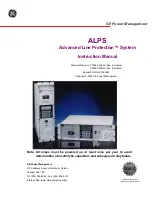
Digital Input Conditioning Function
The relay scans the inputs for status once per 1.0 ms. The relay uses digital contact recognition and
debounce timers that are user settable to condition the signals applied to the inputs. The user can adjust
these parameters so that the optimum compromise between speed and security can be attained for the
specific application. The digital input conditioning function is evaluated every 4 ms.
If the sampled status of the monitored contact is detected closed for the recognition time, the logic
variable changes from an open (logic zero or FALSE) state to a closed (logic one or TRUE) state. Once
the contact closure has been recognized, the logic variable will remain in the closed state until the
sampled status of the monitored contact is detected to be open for longer than the debounce time. At this
point, the logic variable will change from a closed (logic one or TRUE) state to an open (logic zero or
FALSE) state.
Setting the Digital Input Conditioning Function
Settings and labels for the digital input conditioning function are set using BESTCOMS. Alternately,
settings may be made using the SG-IN ASCII command.
Each of the inputs has two settings and three labels. The settings are
Recognition Time
and
Debounce
Time
. The labels include a label to describe the input, a label to describe the
Energized State
, and a label
to describe the
De-Energized State
. Labels are used by the BE1-CDS240’s reporting functions.
To edit the settings or labels, select
Inputs and Outputs
from the
Screens
pull-down menu. Then select
the
Inputs 1-6
or
Inputs 7-12
tab. Refer to Figure 3-8.
Figure 3-8. Inputs and Outputs Screen, Inputs 1-6 Tab
3-16
BE1-CDS240 Input and Output Functions
9365200990 Rev F
Summary of Contents for BE1-CDS240
Page 2: ......
Page 8: ...vi BE1 CDS240 Introduction 9365200990 Rev F This page intentionally left blank ...
Page 38: ...1 28 BE1 CDS240 General Information 9365200990 Rev F This page intentionally left blank ...
Page 40: ...ii BE1 CDS240 Quick Start 9365200990 Rev F This page intentionally left blank ...
Page 152: ...ii BE1 CDS240 Metering 9365200990 Rev F This page intentionally left blank ...
Page 226: ...iv BE1 CDS240 Application 9365200990 Rev F This page intentionally left blank ...
Page 286: ...ii BE1 CDS240 Security 9365200990 Rev F This page intentionally left blank ...
Page 290: ...9 4 BE1 CDS240 Security 9365200990 Rev F This page intentionally left blank ...
Page 292: ...ii BE1 CDS240 Human Machine Interface 9365200990 Rev F This page intentionally left blank ...
Page 306: ...10 14 BE1 CDS240 Human Machine Interface 9365200990 Rev F This page intentionally left blank ...
Page 308: ...ii BE1 CDS240 ASCII Command Interface 9365200990 Rev F This page intentionally left blank ...
Page 342: ...11 34 BE1 CDS240 ASCII Command Interface 9365200990 Rev F This page intentionally left blank ...
Page 349: ...Figure 12 5 Horizontal Rack Mount Front View 9365200990 Rev F BE1 CDS240 Installation 12 5 ...
Page 361: ...Figure 12 17 Typical DC Connection Diagrams 9365200990 Rev F BE1 CDS240 Installation 12 17 ...
Page 372: ...12 28 BE1 CDS240 Installation 9365200990 Rev F This page intentionally left blank ...
Page 468: ...13 92 BE1 CDS240 Testing and Maintenance 9365200990 Rev F This page intentionally left blank ...
Page 512: ...14 42 BE1 CDS240 BESTCOMS Software 9365200990 Rev F This page intentionally left blank ...
Page 544: ...ii BE1 CDS240 Terminal Communication 9365200990 Rev F This page intentionally left blank ...
Page 550: ...ii BE1 CDS240 Settings Calculations 9365200990 Rev F This page intentionally left blank ...
Page 578: ...D 28 BE1 CDS240 Settings Calculations 9365200990 Rev F This page intentionally left blank ...
Page 579: ......
















































